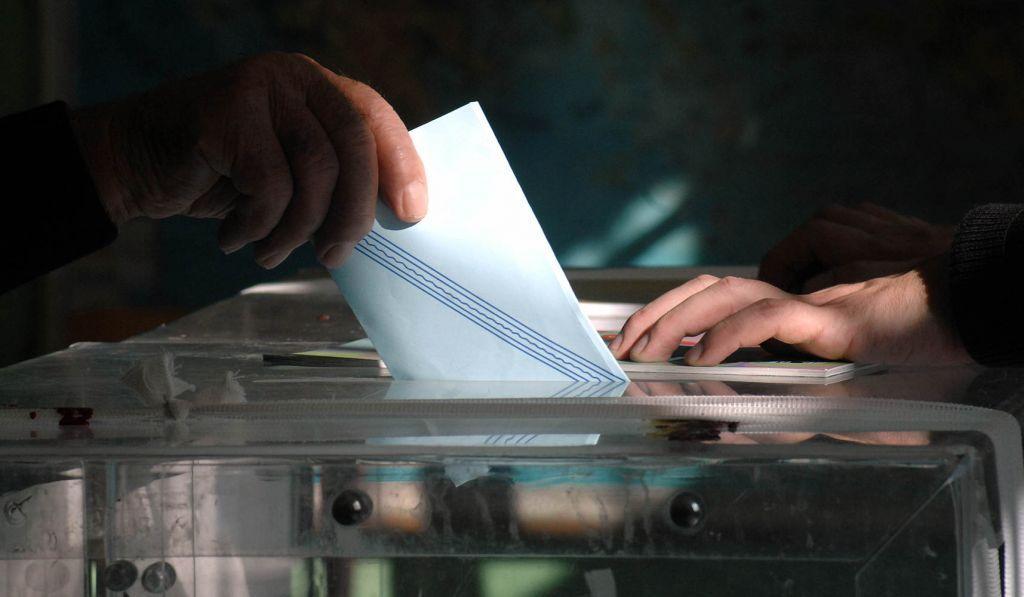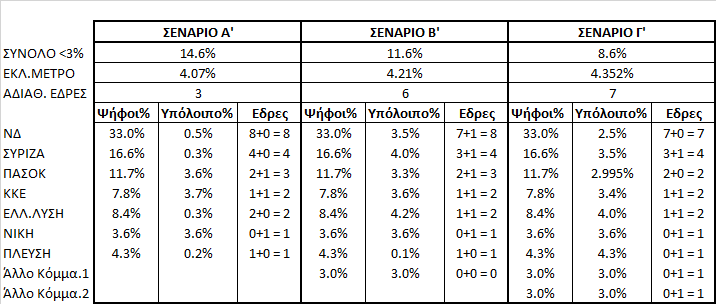
At the end of the pre-election period, most opinion polls seem to be converging on some basic conclusions, but with caution about the exact strength of the parties.
After all, as the number of valid votes is expected to be less than 5 million, the margins of uncertainty due to non-voting have increased sharply in recent days, since at least 50 years of post-colonial history (4.91 million in the 1974 elections), and now even a limit of 4.5 million is seen.
In addition, it can be a “black box” for opinion polls, precisely in the regime of low turnout in the poll, which receives a large number of weights. The 160,000 voters who have already used the process will eventually account for more than 3% of the total voting percentage, which is capable of being pushed to last-minute details.
Assessments
Most polls estimate the ND will be close to its stated target of 33% (in previous European elections), but almost all polls over the past week have shown a slight decline in voter turnout compared to pre-measures levels. However, the ruling party clearly avoided the worst scenarios written till March when it hit its poll pulse.
On the other hand, SYRIZA appears to be relatively stabilized at 16%, approaching but not reaching the percentage of the June 2023 elections (17.8%), especially after the debate “Where are you from” Kasselakis , however, its impact is still not sufficiently assessed. Nevertheless, Syriza appears to have gained the upper hand in the battle for second place, reversing the poll picture that appeared to be emerging six months ago.
As for PaSoK, it seems to be close to 12% now, but it is not certain that this will not show a slight decline compared to last June’s parliamentary elections (11.8%).
The question of 4th place remains open, KKE’s percentages are still a solid 8% or so. The slightly – still – leading Greek solution (8%-9%) maintains to a certain extent the downward trend observed since the beginning of April, although it is undoubtedly one of the parliamentary parties that will now end. Strengthened based on his performance in the parliamentary elections.
Since then, liquidity is shown to have increased, although Nicky and Bluesy show a higher chance of entering the European Parliament, in some cases appearing to be 1% higher than in past national elections.
If the current 7 parliamentary parties (except the Spartans) are indeed confirmed to enter the European Parliament, this would be the first European election in 10 years to produce no reclassification in terms of party competition extremes. , and in terms of the general structure of the party landscape.
The European elections of 2014 announced the replacement of DIMAR by Potami, while 2019 marked the exit of ANEL, Potami and the Union of Centers (to a certain extent Golden Dawn), along with the Hellenic entry. Solution and Section 25.
“Tail” war
From there, there are many parties that claim the 3% threshold (with more or less claims), the New Left and MeRA 25 appeared strong in this race, but a surprise cannot be ruled out in this race due to A. Latinopoulos, the Democrats of A. Loverdos and the Patriots of Pr. Emfietzoglou also seems to hold some limited confidence, with rates estimated above 2% (mostly or not).
The aforementioned overcrowding in the “tail” war would allow us to estimate that the overall percentage of parties that did not exceed 3% would theoretically vary in any value between 5%-6% and 16%-17%, although not achieved. The corresponding records of the 2014 and 2019 European elections (17.1% and 21%).
Distribution of places
Under the above conditions, especially if only 7 parties exceed 3%, the distribution of seats is almost “locked”, as can be seen in the example of Marx’s last poll (6.6.2024). Scene one Table: ND 8 seats, SYRIZA 4, PaSoK 3, 2 from KKE and ELL. Solution, the last two places will be shared between the 6th and 7th parties, ie Niki and Bluesy.
According to the electoral law, seats are distributed on the basis of proportional system of remainder. We recall at this point that after the ND amendment in January 2024, the electoral process was the result of dividing the overall strength of parties exceeding 3% by 21 seats (ie, in Scenario A’). 4.07%)
Initially, seats are allocated to the parties based on the electoral scale, and then the unreserved seats (of which three) are allocated one by one to those who have received unused votes, i.e. the strongest remainder from the division of each party’s strength. Election process.
But what happens if the 8th party is also above 3%?
“Dream” 3% and estimated limits
For each additional party that crosses the 3% threshold, the value of the electoral measure increases by 0.15% or less, based on the above calculation.
So in the previous example, the appearance of one more comma at 3% (Scenario B), raises the electoral scale to 4.21%, increases the unallocated seats to 6, but changes the values of the rest, especially for the first three parties (ND, SYRIZA, PaSoK), already 7, 3 and 2 seats according to the electoral scale, each of which also receives one unallocated seat.
One of these last three places claims to “reduce” the 8th party, but 3% is not enough electoral power for it (which is smaller than the first three parties).
* and + distinguish between those who won and those who did not, based on the electoral metric, in the number of seats
In other words, it is highlighted once again that exceeding 3% is a necessary but not sufficient condition for electing a member of the European Parliament. In other words, it is possible for a party to face the “dream” scenario of more than 3% without winning a seat (author, “European elections: what the new electoral law brings”, du vima, 23.01 .2024), the real “margin of safety” is 3.2%-3.3 % should be placed in the area.
It should be recalled at this point that until the previous European elections, 3% was always the margin of safety for the election of an MEP, as electoral action was calculated based on the total strength of the parties, which was consistently 4.76%. That is clearly elevated from its current variable form. The difference significantly increased the number of unreserved seats, roughly the number of parties entitled to one seat.
In Scenario B, i.e. with the old form of electoral law, the total number of unreserved seats would be 8, i.e. one for each party, regardless of percentage or remainder.
In the specific example of Scenario B, it is not possible to elect an MEP from the 8th party with the current electoral law of 3.25% unless one of the top three parties gets less votes. Indeed, for a percentage of ND below 32% or SYRIZA above 15.5% or PaSoK above 11.5%, it is possible for the 8th party to win a seat, even if marginally by 3%. But the final distribution now moves mostly to the randomness of numerical analysis.
Contradiction
But what if there is another extra (9th point) that makes it more than 3%? Then, the electoral action will reach 4.352%, on the one hand increasing the unallocated seats to 7, and on the other hand mainly reducing the rest of ND, SYRIZA and PASoK, so that the 8th and 9th parties cannot elect an MEP. Even if at least 3% of the votes (Scene C), the percentage that would have been ineffective under the previous scenario B (8 parties).
In other words, the more parties exceed the 3% threshold, the more likely they are to elect an MEP. Or vice versa, if there are fewer parties competing in seat allocation, it is more difficult for all of them to win. Another of the many technical inconsistencies of the proportions of the rest.
Mr. Panagiotis Koustenis Dr. Political Science.

. “Professional creator. Subtly charming web advocate. Unapologetic problem solver. Devoted student.”






More Stories
Criminal gang in Mykonos encouraged women into prostitution – how they set up romantic dates
Earthquake in Kavtos: “Too early to decide if it’s significant” – Valleys closed, risk of landslides
Halkidiki – Luna Park: SKAI Revelation – Discovered by the Expert